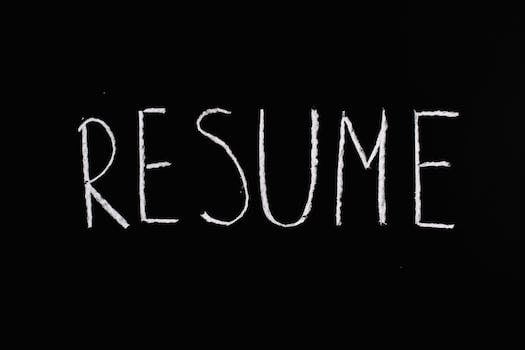How to Craft a Professional Summary for Your CV
A professional summary is a brief statement at the top of your CV that highlights your key skills, experience, and accomplishments. It should be concise and tailored to the job you are applying for.
To craft a professional summary for your CV, start by introducing yourself and your professional title. Then, list your key skills and experience, focusing on those that are most relevant to the job you are applying for. Be sure to include any relevant certifications or qualifications.
Next, provide a brief overview of your career accomplishments. This could include awards, promotions, or any other achievements that demonstrate your value as an employee. Finally, end your summary with a statement that expresses your enthusiasm for the job and your commitment to success.
By following these steps, you can create a professional summary that will help you stand out from the competition and make a great first impression.
How to Highlight Your Skills and Experience on Your CV
When writing your CV, it is important to highlight your skills and experience in order to stand out from other applicants. Here are some tips to help you showcase your skills and experience effectively:
1. Use a clear and concise format. Your CV should be easy to read and should include all relevant information in a logical order.
2. Focus on your relevant skills and experience. Make sure to include any skills or experience that are relevant to the job you are applying for.
3. Use keywords. Use keywords that are related to the job you are applying for to make sure your CV is picked up by applicant tracking systems.
4. Use action words. Use action words such as “developed”, “managed”, or “implemented” to describe your skills and experience.
5. Include quantifiable results. Where possible, include quantifiable results to demonstrate the impact of your work.
6. Proofread. Make sure to proofread your CV to ensure there are no spelling or grammar mistakes.
By following these tips, you can ensure that your CV stands out from the crowd and showcases your skills and experience effectively.
Tips for Writing a CV That Will Stand Out From the Crowd
1. Make sure your CV is tailored to the job you are applying for. Your CV should be tailored to the specific job you are applying for, highlighting the skills and experience that are most relevant to the role.
2. Keep it concise. Your CV should be no more than two pages long. Make sure to include only the most important information and leave out any irrelevant details.
3. Use a professional font. Choose a font that is easy to read and looks professional. Avoid using overly decorative fonts or ones that are difficult to read.
4. Include a professional profile. A professional profile is a brief summary of your skills and experience that should be included at the top of your CV. It should be tailored to the job you are applying for and should be no more than a few sentences long.
5. Use bullet points. Bullet points are an effective way to make your CV easier to read and to highlight the most important information.
6. Include relevant keywords. Many employers use applicant tracking systems to scan CVs for relevant keywords. Make sure to include keywords related to the job you are applying for in your CV.
7. Proofread your CV. Make sure to proofread your CV for any spelling or grammar mistakes before submitting it.
8. Use a professional email address. Make sure to use a professional email address when submitting your CV. Avoid using personal email addresses such as “[email protected]”.
9. Include references. Include the contact details of two or three professional references at the end of your CV.
10. Save your CV in a PDF format. PDFs are the most common format for CVs and are the best way to ensure that your CV looks the same on any device.
How to Format Your CV for Maximum Impact
1. Start with a Professional Summary: Begin your CV with a professional summary that outlines your qualifications and experience. This should be a concise overview of your skills and accomplishments, and should be tailored to the job you are applying for.
2. List Your Work Experience: Include a list of your work experience, starting with your most recent job. Include the job title, company name, dates of employment, and a brief description of your duties and accomplishments.
3. Include Your Education: Include your educational background, including the name of the school, degree, and year of graduation.
4. Highlight Your Skills: Include a section that highlights your skills and qualifications. This should include any technical skills, such as computer programming or web design, as well as any soft skills, such as communication or problem-solving.
5. Include Awards and Certifications: Include any awards or certifications you have received, such as professional certifications or awards for excellence.
6. Use a Professional Format: Use a professional format for your CV, such as a chronological or functional format. This will help ensure that your CV is easy to read and understand.
7. Proofread and Edit: Before submitting your CV, make sure to proofread and edit it for any errors. This will help ensure that your CV is free of any typos or mistakes.
How to Tailor Your CV to the Job You’re Applying For
When applying for a job, it is important to tailor your CV to the specific role you are applying for. This will help you stand out from other applicants and demonstrate to the employer that you are the right person for the job. Here are some tips on how to tailor your CV to the job you’re applying for:
1. Research the job: Before you start writing your CV, take some time to research the job you are applying for. Read the job description carefully and make a list of the skills, qualifications, and experience that the employer is looking for.
2. Highlight relevant skills and experience: Once you have identified the skills and experience that the employer is looking for, make sure to highlight these in your CV. Focus on the skills and experience that are most relevant to the job and make sure to include any relevant qualifications or certifications.
3. Use the right keywords: Many employers use applicant tracking systems (ATS) to scan CVs for keywords. Make sure to include the keywords from the job description in your CV to ensure that your CV is picked up by the ATS.
4. Customize your CV for each job: Don’t just send out the same CV for every job you apply for. Take the time to customize your CV for each job you apply for. This will help you stand out from other applicants and demonstrate to the employer that you are the right person for the job.
By following these tips, you can tailor your CV to the job you’re applying for and increase your chances of getting an interview. Good luck!





